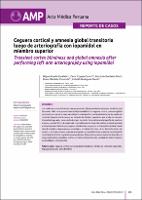Ceguera cortical y amnesia global transitoria luego de arteriografía con iopamidol en miembro superior
Related Resource(s)
https://amp.cmp.org.pe/index.php/AMP/article/view/1188Date
2020-12-27Author(s)
Hueda-Zavaleta, Miguel
Copaja-Corzo, Cesar
Bardales-Silva, Fabrizzio
Minchón-Vizconde, Diana
Rodríguez-Tanta, Lisbeth
Metadata
Show full item recordAlternate title
Transient cortex blindness and global amnesia after performing left arm arteriography using iopamidol
Abstract
Los medios de contraste iodados pueden presentar diferentes efectos adversos, siendo los más frecuentes daño renal y reacciones de hipersensibilidad. La ceguera cortical y amnesia global transitoria son complicaciones neurológicas raras descritas tras la administración de medios de contraste. Reportamos el caso de un paciente de 63 años, hipertenso que acude por cianosis, frialdad del segundo y tercer dedo de mano izquierda. Es sometido a arteriografía de miembro superior, usando 50 mL de iopamidol e inmediatamente desarrolla cefalea occipital asociada a visión borrosa bilateral que progresa rápidamente a ceguera; la tomografía cerebral reveló hiperdensidades subaracnoideas occipitales, sin efecto de masa. A las dieciocho horas del evento, el paciente presenta amnesia anterógrada con persistencia de amaurosis. Su tomografía cerebral de control no muestra trastornos focales. El paciente cursa con evolución favorable, la amaurosis bilateral y la cefalea ceden a las treinta horas del evento y es dado de alta sin mayores eventualidades a los diez días. Iodinated contrast substances may cause different adverse events, most frequently renal involvement and hypersensitivity reactions. Transient cortical blindness and global amnesia are rarely described neurological complications after the administration of contrast substances. We report the case of a 63-year old patient with high blood pressure who presented with cyanosis and cold sensation affecting the second and third digits of his left hand. The patient underwent an arteriography of the left arm, where 50-mL of iopamidol was used as a contrast substance, and he immediately developed occipital headache associated to bilateral blurred vision that rapidly progressed to blindness. A cerebral computed tomography (CT) scan showed occipital subarachnoid hypodense areas, with no mass effect. Eighteen hours after the event, the patient showed retrograde amnesia with persistent amaurosis. His control cerebral CT scan did now show any focal disorder. The patient had a good progression, both bilateral amaurosis and headache subsided thirty hours after the event, and the patient was uneventfully discharged after ten days.
Collections
- Artículos científicos [890]






